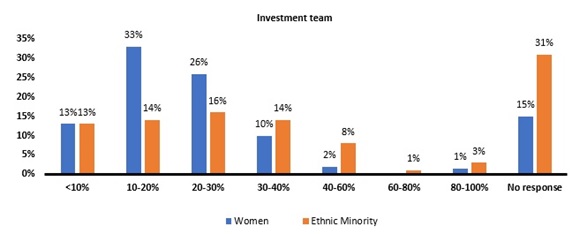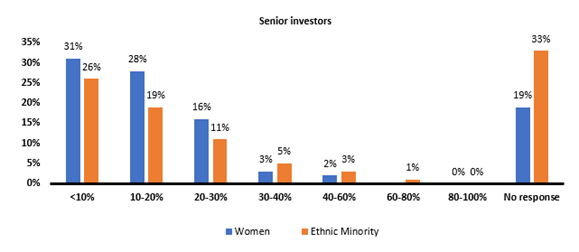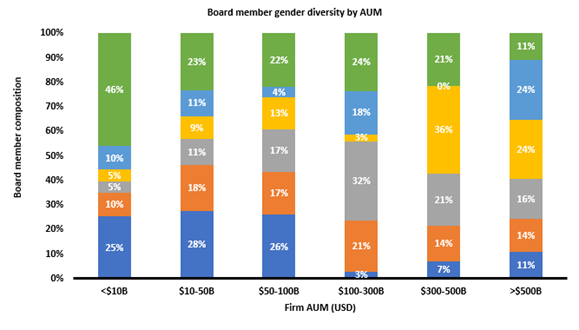2022 ESG survey deep dive: DEI review
Executive summary:
- Generally speaking, our ESG (environmental, social, governance) survey revealed that disclosures in the investment industry are greater for gender than for ethnicity.
- Roughly half of the asset managers we surveyed have gender or ethnic-minority representation of less than 20% on their investment staff.
- Gender diversity in board membership is greater than ethnic minority diversity.
Our 2022 ESG Manager Survey findings
Our 2022 ESG Manager Survey findings reinforced our belief that well-executed diversity, equity and inclusion (DEI) practices are a sign of well-run teams and can lead to better investment outcomes. There continues to be a growing effort to promote DEI practices in the asset management community, in order to recruit and retain a more diverse talent pool, increase employee engagement through diverse representation and empower broader perspectives and thinking. We have observed that many asset managers are taking DEI issues seriously, with a key focus on tackling the societal challenges of inequality in the workplace, as well as recognizing the importance of having diverse talent and investment ideas. The application of supportive DEI efforts is necessarily multi-faceted, as diversity issues pertain to gender, ethnicity, sexual orientation, disabilities and social backgrounds. For this reason, we dedicate one portion of our survey to DEI, and we conduct a deep-dive review of the responses. This informs our industry views, our expectations for the asset managers we assess, recommend and hire, and our own practices. Let’s dig in and take a look.
Disclosure on diversity, equity and inclusion data – Greater for gender than for ethnicity
The investment industry has a lack of diversity. In our survey, we asked participants what the female representation is at the following levels: total firm, investment team, senior investment team and board membership. We also asked the same set of questions about ethnic minority representation. Generally speaking, we have observed that disclosures are greater for gender than for ethnicity—likely due to the fact that some firms only have data on the gender of their employees (often due to legal prohibitions or other difficulties in gathering information about ethnicity). For instance, 85% of respondents disclosed the percentage of their total female employees, while only 69% did so for ethnic minorities.
For the ethnic minority disclosure, disclosure was greatest in the U.S., where 85% of U.S.-based respondents disclosed their DEI statistics around ethnic minorities, and 90% disclosed their gender demographics. The ethnic minority disclosure was lowest among firms based in continental Europe, which is understandable, given the regulatory differences. In particular, it’s illegal for companies to collect and/or disseminate diversity-related information in some European countries.
Exhibit 1: DEI profile of investment team
Click image to enlarge

Of the firms that disclosed their DEI statistics, most (54%) have investment teams comprised of less than 20% women, and 40% have investment teams where less than 20% of the members are ethnic minorities. In other words, roughly half of the asset managers we surveyed have gender or ethnic-minority representation of less than 20% on their investment staff. Perhaps this provides a reference point of the general demographics of the industry.
Minority ownership structure is one measure of DEI considerations, but has its own challenges. First, it tends to center around certain companies, and often excludes firms like publicly traded entities (that are responsible to underlying shareholders) or subsidiaries (who don’t have direct ownership of the company). Perhaps unsurprisingly, then, only 53% of respondents disclosed their ownership structure. Of these, 82% disclosed that women comprise less than 20% of their overall ownership structure. In addition, 89% of respondents disclosed that ethnic minorities comprise less than 20% of their ownership structure. These results point to the lack of ownership by underrepresented groups.
Where diversity is stronger – Gender diversity in boardrooms
When comparing the diversity profile of a firm’s overall employees to that of an investment team within the firm, we found that gender diversity is greater at the overall employee level than at the investment-team level. Specifically, 65% of respondents indicated that female employees represent 30% to 60% of their workforce. However, within investment teams specifically, 72% of respondents stated that females comprise less than 30% of their team. This suggests that the average number of female professionals working on investment teams is lower than the average number of females working in the financial industry overall. In other words, there are probably less female professionals on investment teams than on other teams within an organization.
In order to examine the diversity demographics of investment teams further, we asked what the composition was of investment professionals who are considered as senior with key decision-making authorities. We designed this question to be purposefully subjective around what constitutes a senior investor, because each organization has different titles and organization structures. That said, the answers provide some perspective on the diversity representation among senior investment professionals. Overall, less than 10% of senior investment professionals who are either females or ethnic minorities make up over 30% of senior investment teams. This data suggests greater challenges in diversity demographics of senior investors, perhaps pointing to career progression barriers for people from underrepresented groups.
Exhibit 2: DEI profile of senior investment team
Click image to enlarge

We also found that gender diversity in board membership is greater than ethnic minority diversity. Our survey shows that just 48% of respondents have less than 20% of board members who are female, whereas 89% of respondents who disclosed this data have less than 20% of board members who belong to an ethnic minority group. In other words, not many firms have ethnic minority representation in their board membership. It’s also worth pointing out that while gender diversity is indeed greater than ethnic minority diversity, of all the respondents who disclosed this data, only 17% of firms have boards where greater than 40% of members are women.
Exhibit 3: Board member diversity
Click image to enlarge

One final note is that when comparing the gender and racial diversity by firm AUM, boardroom gender diversity is greater for larger firms. This is understandable, given that large firms have more resources to apply to recruiting. They are also more likely to be public, which results in greater scrutiny and pressure to demonstrate DEI commitments.
The bottom line
Having this set of DEI data for the asset management community allows us to measure where the industry is at and then monitor how we progress forward. Our survey results, combined with our day-to-day experiences in the investment industry, illustrate how the DEI discussion is ever-changing—and that a host of questions still remain over how DEI data should be compiled and interpreted.
Overall, the survey reveals that our clients, especially in the U.S., see DEI as one of the top considerations when it comes to ESG-related topics. Even more importantly, however, the responses confirm that the trend toward considering DEI factors as part of an organization’s investment process is unmistakably accelerating. In short, more and more clients are asking questions—and asset managers need to be prepared. Ultimately, managers need to understand that disclosing this data is an important responsibility in itself, regardless of what the data says. The investment community as a whole has plenty of room for improvement. Being open and transparent is a valuable first step.
Receive the full 2022 ESG Manager Survey